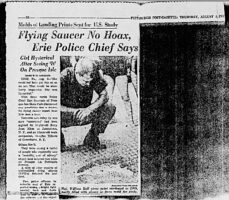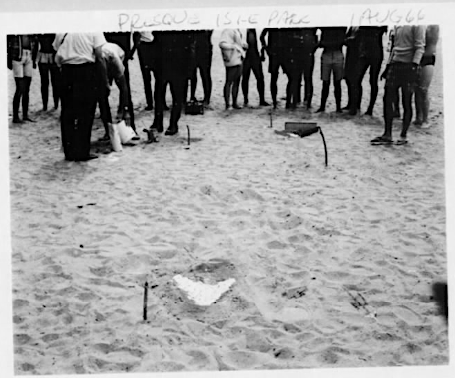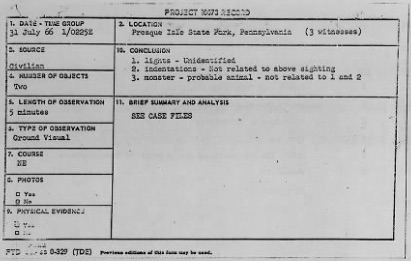by Charles Lear, author of “The Flying Saucer Investigators.”
 In 1966, John Keel, longtime fortean and author of several books on UFOs, including his most famous book published in 1975, The Mothman Prophecies, was just beginning to focus on the UFO phenomenon. At this time in his life, he was writing articles for the British publication, Flying Saucer Review and sharing his research with Jim and Coral Lorenzen of the Aerial Phenomena Research Organization. He wrote an article (page 6 of pdf) about one case he looked into that year, headlined “New Landing and Creature Reports” that was published in the November-December 1966 Flying Saucer Review. The article’s main focus is on one incident that took place on July 31, 1966. Keel shared the details of the case with APRO, and they published their take on it (page 3 of pdf) headlined, “The Presque Isle Landing,” in the July-August 1966 APRO Bulletin.
In 1966, John Keel, longtime fortean and author of several books on UFOs, including his most famous book published in 1975, The Mothman Prophecies, was just beginning to focus on the UFO phenomenon. At this time in his life, he was writing articles for the British publication, Flying Saucer Review and sharing his research with Jim and Coral Lorenzen of the Aerial Phenomena Research Organization. He wrote an article (page 6 of pdf) about one case he looked into that year, headlined “New Landing and Creature Reports” that was published in the November-December 1966 Flying Saucer Review. The article’s main focus is on one incident that took place on July 31, 1966. Keel shared the details of the case with APRO, and they published their take on it (page 3 of pdf) headlined, “The Presque Isle Landing,” in the July-August 1966 APRO Bulletin.

The incident Keel wrote about happened on Presque Isle in Erie, Pennsylvania. Presque Isle is, in Keel’s words, “a hook-shaped peninsula encompassing Erie Harbour on Lake Erie.” He describes it as a state park with 11 beaches and an “administration building” housing a Coast Guard station and a police dispatch office. At night, the dispatch office was manned by a single person who transmitted to two patrol officers.
According to Keel, Betty Jean Klem, 16, Douglas J. Tibbets, 18, Gerald LaBelle, 26, Anita Haifley 22, and her two children, one 2 months old and one 6 years old, arrived by car at beach number 6 at 8 p.m. for a picnic. As they pulled up to a picnic table, the car got stuck in the sand.
La Belle went to get some help, and the rest waited. Patrolmen Clark and Loeb (first names Ralph and Robert from the APRO Bulletin) were driving by and they stopped to check on the group. Tibbets told them they were okay and the patrolmen left. The group then packed up and sat in the car to wait for LaBelle. Tibbets and Klem sat in the front seat and Haifley got in the back seat with her children who were falling asleep.
The car was surrounded on three sides by trees and bushes with bushes that were about 12 feet tall in the front. Sometime between 9:30 and 10:00 p.m., Tibbets and Klem reportedly caught sight of an unusually bright star. As they watched, it grew larger and then seemed to be heading towards them. When it got close enough they could make out a form behind the brilliant white light. It then dropped down onto beach number 7 beyond the bushes in front of them.
 Klem described the object as being “as big as a house” and “mushroom-shaped.” She said she saw lights on the back of the object. Tibbets described it as “triangular” to one of the patrolmen, “shaped like a cake” to a newspaper reporter, and “hexagonal” and hollowed out in the center on a local radio show.
Klem described the object as being “as big as a house” and “mushroom-shaped.” She said she saw lights on the back of the object. Tibbets described it as “triangular” to one of the patrolmen, “shaped like a cake” to a newspaper reporter, and “hexagonal” and hollowed out in the center on a local radio show.
According to Tibbets and Klem, the object came down 150 yards in front of them, and as it did so, it turned a brilliant red and the car “vibrated and shook.” They said they heard a loud buzzing or humming “like a telephone receiver makes,” and scratching noises “as if someone was walking on the roof.” According to Keel, Tibbets found a dent and some scratches on the roof.
Tibbets and Klem reported that after the object seemingly landed, it emitted beams of white light that fanned out towards the woods. Tibbets said there were 9 to 12 beams, though he was later quoted in the newspapers as saying there was only one like a searchlight. Klem said, “We just couldn’t believe it was really happening.”
Clark and Loeb drove by, and according to Tibbets, the lights from the object went out. Tibbets got the patrolmen to stop by flashing the brake lights and then ran towards them saying, “There’s something weird going on here.” The three men walked out to the beach and as they did, Klem, who was still in the car, shouted to Haifley, “Don’t look! There’s somebody out there!”
Klem later told police and reporters that she saw a tall figure in front of the car. She said she couldn’t see its legs and saw it had a head by leaning forward and looking up through the windshield. She insisted it was not human or any animal she had ever seen before. According to Keel, Klem laid into the horn and blew continuously as the creature “sluggishly” moved off into the woods.
 The men didn’t see anything unusual when they went to investigate. When they heard the horn, they ran back to the car. As they were running up, Klem jumped out and started to run in a state of hysterics. Clark stopped her, and the men did what they could to calm her down. Tibbets said he’d never seen her act that way in the ten years he’d known her.
The men didn’t see anything unusual when they went to investigate. When they heard the horn, they ran back to the car. As they were running up, Klem jumped out and started to run in a state of hysterics. Clark stopped her, and the men did what they could to calm her down. Tibbets said he’d never seen her act that way in the ten years he’d known her.
According to Keel, Klem’s panic was “contagious” and the men decided it would be best if everyone left. They all got into the patrol car and headed for the administration building. Keel describes the man at the dispatcher’s desk, Officer Wilson, as saying that when he saw Haifley walk in with her sleeping children, he thought they’d been drowned.
According to Keel, flying saucer stories had been in the local papers in the last week and were nothing new to the officers. Wilson called Park Superintendent Michael E. Wargo and Park Police Chief Dan Descanio.
Klem was still in a frightened state and refused to sit with her back to the window. Her hysteria seemed genuine to the officers. Descanio later told reporters, “I know what people are going to say, but that girl saw something that scared her badly. This is no joke as far as I’m concerned.” Descanio was impressed enough to call Air Technical Intelligence Command at Wright-Patterson AFB to report the incident.
Tibbets and Klem came back to isle the next night and asked for permission to sit at the beach overnight because Tibbets had heard that flying saucers often return to the same spot over several days. Their request was denied.
Two other officers, Paul H. Wilson and J. Robert Canfield, stopped by the site the next morning and saw two 18 inch, triangular impressions that sloped down to a depth of 8 inches. They found three more identical impressions and two “skid marks.” They also found 9-inch-diameter, 6-inch-deep, cone-shaped imprints “as if someone had pressed a pointed drinking cup into the sand.” These went from the reported landing site to about 12 feet from where the car was.
The men also found wet spots of sand that were sticky. They told Keel that most liquids evaporate quickly on the beach. Samples were collected in plastic bottles. One officer told Keel that he had a sample analyzed privately by a relative who was a chemist and that it was identified as silicon. He said that when it dried, it formed a plastic-like substance.
Keel describes the Air Force investigation. According to him, they made plaster casts of the impressions and then “kicked over the traces, destroying the markings.” They also took all the bottles of sand. According to Keel, Descanio said he told the Air Force investigators that there were no bears in the area. Keel then describes the Air Force stating that “raccoons and bear are known to be in that area” and that there was nothing unusual in the samples “except urine.” The Project Blue Book Record Card has the conclusion that the lights are “unidentified,” the marks are “not related”, and the “monster” was an unrelated “probable animal.”
According to Keel, the officers maintained their belief, and he notes that each one came to him separately and asked specifically about UFO reports involving kidnappings, about which they seemed “especially interested.”
APRO’s coverage is very much the same as Keel’s, but they add the details involving the presence of a National Investigations Committee on Aerial Phenomena Buffalo, New York, subcommittee. According to APRO, the group “arrived, interviewed witnesses, posed for photographers, etc.” The NICAP group weren’t impressed and declared the incident “a probable hoax.”
Keel includes a couple of UFO reports in the area the same night and wraps up his article with a couple of creature sightings. According to him, a witness in Erie, Pennsylvania, claimed she was awakened at 5:30 a.m. on August 3rd by the barking of neighborhood dogs. She went to a window and saw a creature she described as 5’-6” tall, wearing a yellow jacket and pants that had no pockets or belts she could see. She said it had a huge moon-shaped head that, when seen from the side, was flat in the back. The head was covered in “straggly” mud-colored brown hair. She said it moved “like a mechanical wind-up toy” holding it arms at its sides. Its arms didn’t move and its legs didn’t bend. As it went on its way, it ignored the barking dogs at its heels.
Keel adds that another woman told him that that same week she was driving down 3rd Street “when she saw the creature and stopped the car.” It came up and “pounded on the hood” and then went off into the night.
Podcast: Play in new window | Download